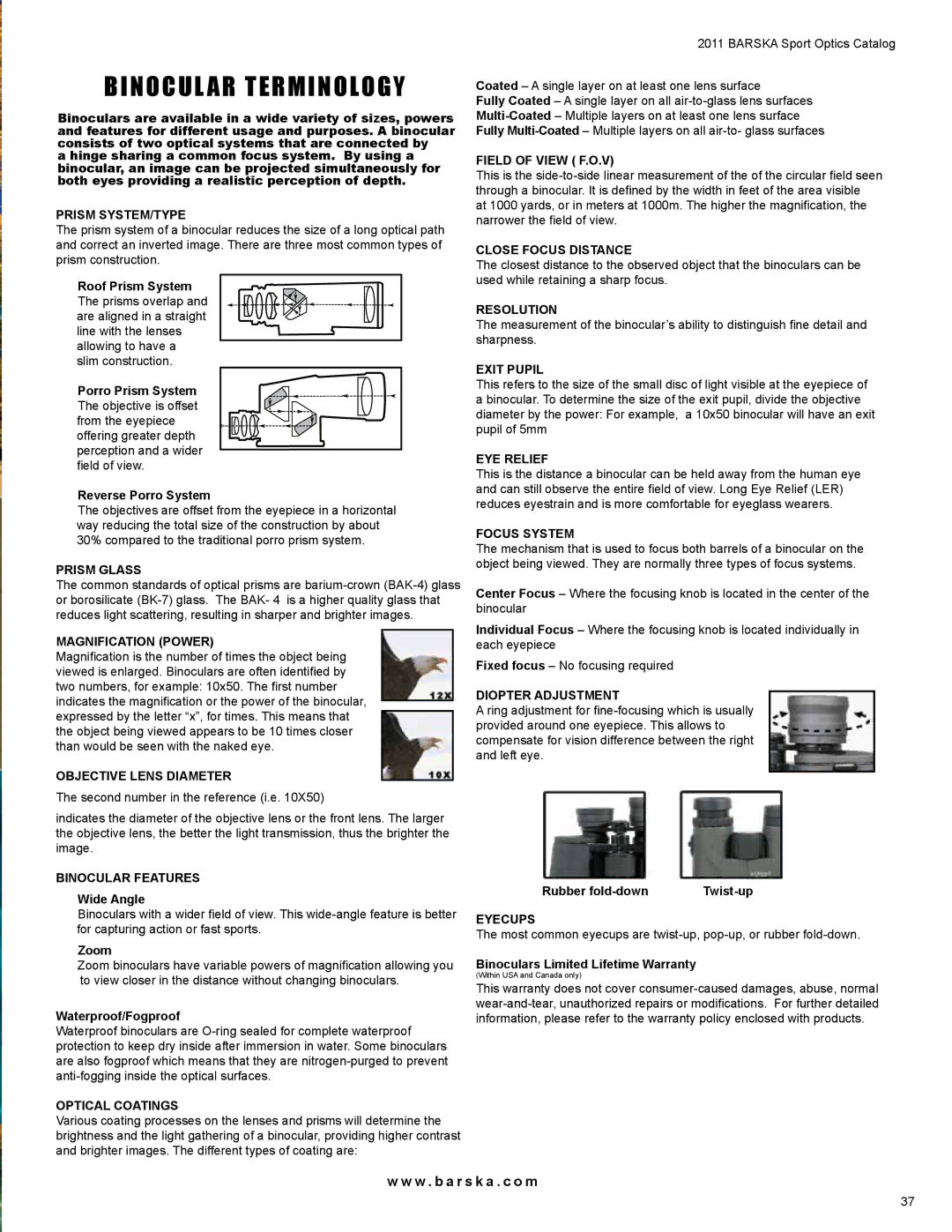
BINOCUL AR TERMINOLOGY
Binoculars are available in a wide variety of sizes, powers and features for different usage and purposes. A binocular consists of two optical systems that are connected by
a hinge sharing a common focus system. By using a binocular, an image can be projected simultaneously for both eyes providing a realistic perception of depth.
PRISM SYSTEM/TYPE
The prism system of a binocular reduces the size of a long optical path and correct an inverted image. There are three most common types of prism construction.
Roof Prism System The prisms overlap and are aligned in a straight line with the lenses allowing to have a slim construction.
Porro Prism System The objective is offset from the eyepiece offering greater depth perception and a wider field of view.
Reverse Porro System
The objectives are offset from the eyepiece in a horizontal way reducing the total size of the construction by about 30% compared to the traditional porro prism system.
PRISM GLASS
The common standards of optical prisms are
MAGNIFICATION (POWER)
Magnification is the number of times the object being viewed is enlarged. Binoculars are often identified by two numbers, for example: 10x50. The first number indicates the magnification or the power of the binocular, expressed by the letter “x”, for times. This means that the object being viewed appears to be 10 times closer than would be seen with the naked eye.
OBJECTIVE LENS DIAMETER
The second number in the reference (i.e. 10X50)
indicates the diameter of the objective lens or the front lens. The larger the objective lens, the better the light transmission, thus the brighter the image.
BINOCULAR FEATURES
Wide Angle
Binoculars with a wider field of view. This
Zoom
Zoom binoculars have variable powers of magnification allowing you to view closer in the distance without changing binoculars.
Waterproof/Fogproof
Waterproof binoculars are
OPTICAL COATINGS
Various coating processes on the lenses and prisms will determine the brightness and the light gathering of a binocular, providing higher contrast and brighter images. The different types of coating are:
2011 BARSKA Sport Optics Catalog
Coated – A single layer on at least one lens surface
Fully Coated – A single layer on all
FIELD OF VIEW ( F.O.V)
This is the
at 1000 yards, or in meters at 1000m. The higher the magnification, the narrower the field of view.
CLOSE FOCUS DISTANCE
The closest distance to the observed object that the binoculars can be used while retaining a sharp focus.
RESOLUTION
The measurement of the binocular’s ability to distinguish fine detail and sharpness.
EXIT PUPIL
This refers to the size of the small disc of light visible at the eyepiece of a binocular. To determine the size of the exit pupil, divide the objective diameter by the power: For example, a 10x50 binocular will have an exit pupil of 5mm
EYE RELIEF
This is the distance a binocular can be held away from the human eye and can still observe the entire field of view. Long Eye Relief (LER) reduces eyestrain and is more comfortable for eyeglass wearers.
FOCUS SYSTEM
The mechanism that is used to focus both barrels of a binocular on the object being viewed. They are normally three types of focus systems.
Center Focus – Where the focusing knob is located in the center of the binocular
Individual Focus – Where the focusing knob is located individually in each eyepiece
Fixed focus – No focusing required
DIOPTER ADJUSTMENT
A ring adjustment for
Rubber |
EYECUPS
The most common eyecups are
Binoculars Limited Lifetime Warranty
(Within USA and Canada only)
This warranty does not cover
w w w . b a r s k a . c o m
37
